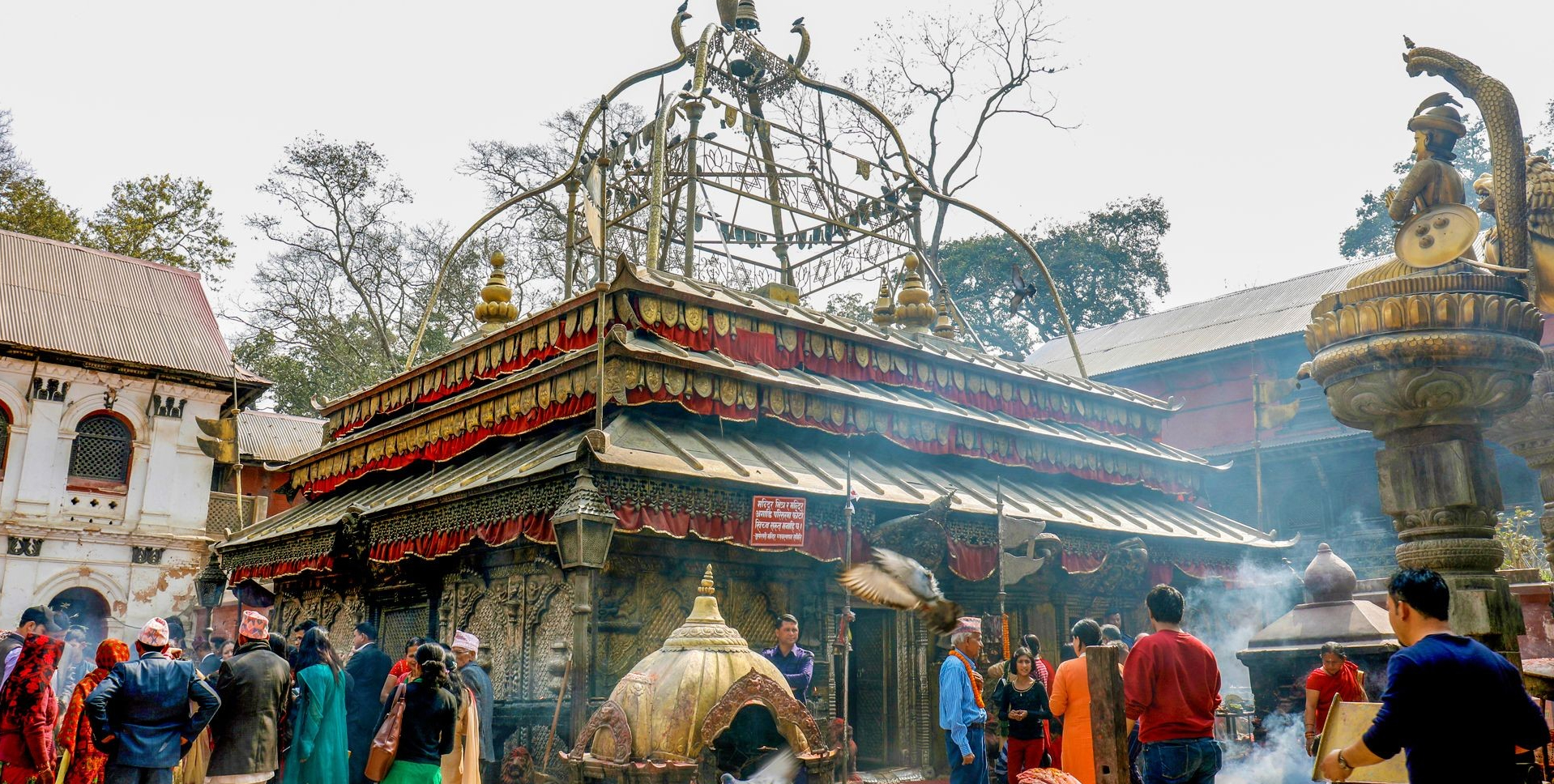Guhyeshwari (also called as Guhjeshwari/Guheswari) is a famous Hindu temple in the Kathmandu Valley. This temple is located on the southern bank of the river Bagmati. It is believed that this temple was named as Guhyeshwari (Guhriyeshwari) because the Goddess of this temple originated in the place where Sati Devi’s Guriya fell. Buddhists and Hindus alike have been worshiping Guhyeshwari Devi. Buddhists have worshiped Guhyeshwari as Nairatma Devi and Hindus as Niranjan Nirakar. Guhyeshwari Devi is one of the four yoginis believed by Buddhists
It is also believed that the other 33 deities were first worshiped in this place. Special worship is performed at Guhyeshwari from the time of Ghatasthapana. There are no idols of goddesses here. There is a sanctum sanctorum of the temple at the place where Goddess Sati fell. There is only a small pool where the pilgrims worship the water tank inside the temple covered with silver urns as a goddess. The glory of Guhyeshwari is mentioned in Nepal Mahatmya, Himavat Khanda, Sriswasthani Bratakatha etc.
Origin of Guhyeshwari
According to the story of Shri Swasthani, daughter Sati Devi and son-in-law Mahadev were not invited to the Ashwamedha Yajna performed by Daksha Prajapati. When Sati Dev came to know that only herself and Mahadev were not invited but all the deities were called from Narad, she went to the palace where Yajna was performing. When Sati Devi asked his father why he didn’t call us only, her father Daksha Prajapati looked at Mahadev and started insulting him saying insane, ghost, phantoms, marijuna eater, vampire, beetles walking back and forth etc.
After listening to all these, Sati Devi couldn’t bear the humiliation, and jumped into the altar and died. After the death of Sati Devi, Mahadev walked around carrying the dead body of Sati Devi. While walking continuously, the genitals of Goddess Sati fell near to Bagmati River from where Goddess Guhyeshwari originated.
Architecture
Located near the Bagmati River, this temple is surrounded by silver doors carved with urns, and there are stone lions on the left and right. There is no gate in the temple of these goddesses, but the upper corner of the temple is covered with gold-plated snakes. Inside the sanctum sanctorum, a golden lotus flower with eight leaves is seen on a circular leaf and a gold urn is placed in the middle. The same urn is worshiped as Guhyeshwari Devi.
Boiled eggs are offered in the water of the tank under the urn along with fish, liquor, and jaundice. While fetching water from the tank, people have come to believe that if they come across the eggs and fish in the tank, they will be lucky, get wealth and prosperity. It is believed that if the water in this tank dries up, there will be famine in the country.
Myth related to Guhyeshwari Temple
King Pratap Malla inscribed a stone inscription on a stone pillar with a tortoise outside the Guhyeshwari temple. It is mentioned that the temple of Guhyeshwari was built on the day of Baisakh Shukla Ekadashi and idols of Ganesh and Bhairav were also being erected. Similarly, as mentioned in the history, the last Malla king of Kathmandu, Jayaprakash Malla, was staying in the temple of Guhyeshwari Devi for a few days when Rani Dayawati conspired to oust him. King Jayaprakash Malla was very sad and continued to serve Goddess Guhyeshwari with devotion. Goddess Guhyeshwari was pleased with the devotion of King Jayaprakash and gave him the sword to make the king powerful. And King Jayaprakash is said to have succeeded in re-ruling his country by taking the soldiers who came to capture him
Guhyeshwari Jatra
Every year on the day of Marg Krishna Dashami, a procession is made to Guhyeshwari, one of the Shakti Peeths of Kathmandu Valley. Before the procession of Goddess Guhyeshwari, on the day of Marg Krishna Ashtami, a 32-handed lingo is built and worshiped. Good religious date is selected to build the lingo. Soldiers from the Summerjung Company bring the wood needed to build the lingo. The journey to Guhyeshwari begins only after the lingo has been worshipped. On the day of Navami, after making a pilgrimage to Guhyeshwari, devotees visit Hanumandhoka Durbar to bring Taleju Bhavani.
There is no statue of Taleju Bhavani. In the place of the idol, the urn in the shape of a triangular and eight-leaf lotus flower on a round metal leaf is Taleju Bhavani. Seen in this way, the statues of Guhyeshwari and Taleju Bhavani look the same. Therefore, Guhyeshwari Devi is also said to be a form of Taleju Bhavani.
Taleju Bhavani is also placed in the khat, and the traditional instrument is played with royal honors. After reaching the Guhyeshwari temple, Taleju Bhavani is kept inside the temple. Gupti is worshiped at night in a tantric manner. A goat is sacrificed. When a goat is sacrificed, it is given to Bhairav inside the temple instead of to Guhyeshwari and Taleju Bhavani. And the same sacrificial goat is offered to Guhyeshwari and Taleju Bhavani.
On the day of Marg Krishna Dashami, the main procession of Goddess Guhyeshwari is performed. Guhyeshwari Devi and Taleju Bhavani are worshiped in the afternoon on behalf of the Guthi and taken to Hanumandhoka Durbar. The Guru’s platoon fires cannons as they bring the goddesses on their journey. The lingo is poured before the khat of Guhyeshwari and Taleju Bhavani. After reaching the Hanumandhoka palace, the khats taken by the pilgrims are sent to Taleju Bhavani, while the khats of Guhyeshwari are placed on the floor of the Jagannath Deval temple. The next day, on the morning of Ekadashi, the Salmis of Chasan Tole play the instruments and sing the hymns of Guhyeshwari Devi. The procession of Guhyeshwari Devi ends at 12 noon after welcoming Guhyeshwari Devi to the temple of Taleju Bhavani.
-By: Kusum Kharel for Land Nepal




